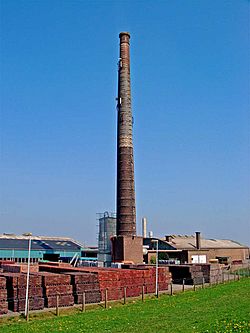Factory facts for kids

A factory is a large building where workers use machines to make many products. These products are then made ready for sale. Factories often use a method called mass production. This means they make many of the same item very quickly.
Contents
What is a Factory?
A factory is like a giant workshop. It's where companies create all sorts of items we use every day. Think about cars, clothes, toys, or even food. All these things are often made in factories. Inside, you'll find different machines and people working together. They follow steps to turn raw materials into finished products.
How Factories Make Things
Factories are designed to make things efficiently. This means they try to make as many items as possible, as fast as possible, and with good quality.
- Raw Materials: It all starts with basic materials. For example, a car factory needs metal, plastic, and rubber.
- Machines: Special machines cut, shape, assemble, and finish the products. Some machines are very big and powerful.
- Workers: People operate the machines, check quality, and manage the production process.
- Assembly Lines: Many factories use assembly lines. This is where products move from one workstation to the next. Each worker or machine adds a part or performs a task. This helps make things quickly and smoothly.
The Idea of Mass Production
Mass production is a key part of many factories. It means making a very large number of identical items. Imagine baking one cookie at a time versus baking hundreds at once. Mass production is like baking hundreds. This method helps companies make products cheaper and faster. This way, more people can afford to buy them.
Factories Through History
Factories have changed a lot over time. They played a huge role in a period called the Industrial Revolution.
Early Factories
Before factories, most things were made by hand in homes or small workshops. The Industrial Revolution, which started in the late 1700s, changed everything. New machines were invented, like the power loom for making cloth. These machines were too big and expensive for homes. So, special buildings were built to house them. These were the first true factories.
Factories in the Industrial Revolution
During the Industrial Revolution, factories grew very quickly. They brought many people from farms to cities to work. However, working conditions in these early factories were often very hard.
- Long Hours: Workers often spent 12 to 16 hours a day in the factory.
- Low Pay: Wages were often very low, barely enough to live on.
- Dangerous Conditions: Machines were not always safe. Accidents were common. Factories could also be dirty, noisy, and poorly lit.
- Child Labor: Sadly, even children worked in these factories. They did dangerous jobs for very little money.
Over time, people fought for better working conditions. Laws were passed to make factories safer and fairer for workers.
Modern Factories Today
Today's factories are much different. They are often cleaner and safer. Many use advanced technology like robots and computers. These technologies help make products even more efficiently. Robots can do repetitive or dangerous tasks. This allows human workers to focus on more skilled jobs. Modern factories continue to evolve, using new ideas to make the things we need.
Images for kids
-
Volkswagen factory in Wolfsburg, Germany
-
Entrance to the Venetian Arsenal by Canaletto, 1732.
-
Interior of the Lyme Regis watermill, UK (14th century).
-
Cromford Mill as it is today.
-
Working day ends at Tampella factory in Tampere, Finland in 1909
-
A factory worker in 1940s Fort Worth, Texas, United States.
-
Coldharbour Mill textile factory, built in 1799.
-
New Lanark mill
-
Workers in the fuse factory, Woolwich Arsenal late 1800s
-
The assembly plant of the Bell Aircraft Corporation at Wheatfield, New York, United States, 1944
-
Interior of the Rouge Tool & Die works, 1944
-
Hyundai's Assembly line (about 2005)
-
Danisco Sweeteners factory in Kotka, Finland (2015)
-
First stages of Saturn V rockets being manufactured at the NASA Michoud rocket factory in the 1960s
-
Space station modules being manufactured in the Space Station Processing Facility
-
A ladle pouring molten steel into a Basic Oxygen Furnace for secondary steelmaking, inside a steel mill factory in Germany
-
Airplanes being manufactured at the Boeing Everett Factory assembly line
See also
 In Spanish: Fábrica para niños
In Spanish: Fábrica para niños























